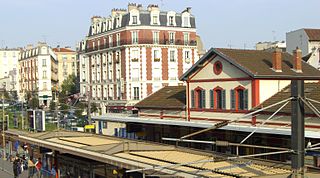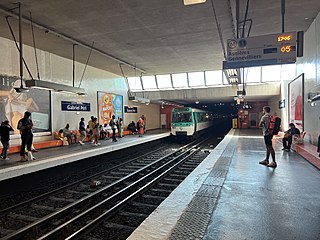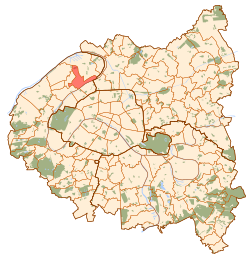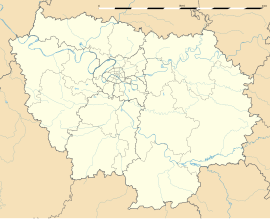
Pointillism is a technique of painting in which small, distinct dots of color are applied in patterns to form an image.

Rueil-Malmaison or simply Rueil is a commune in the western suburbs of Paris, in the Hauts-de-Seine department, Île-de-France region. It is located 12.6 kilometres from the centre of Paris. It is one of the wealthiest suburbs of Paris.

Gennevilliers is a commune in the northwestern suburbs of Paris, in the Hauts-de-Seine department of Île-de-France. It is located 9.1 km (5.7 mi) from the centre of Paris.

Pontoise is a commune north of Paris, France. It is located 28.4 km (17.6 mi) from the centre of Paris, in the "new town" of Cergy-Pontoise.

La Garenne-Colombes is a commune in the northwestern suburbs of Paris, France. It is located 9.6 km (6.0 mi) from Notre Dame de Paris, France's kilometre zero.

Levallois-Perret is a commune in the Hauts-de-Seine department and Île-de-France region of north-central France. It lies on the right bank of the Seine, some 6 km (3.7 mi) from the centre of Paris in the north-western suburbs of the French capital. It is the most densely populated town in Europe and, together with neighbouring Neuilly-sur-Seine, one of the most expensive suburbs of Paris.

Clichy is a commune in the northwestern suburbs of Paris, France. It is located on the Seine, 6.4 km (4.0 mi) from the centre of Paris.

Chevilly-Larue is a commune in the southern suburbs of Paris, France. It is located 9.3 km (5.8 mi) from the center of Paris.

La Celle-Saint-Cloud is a commune in the Yvelines department in the Île-de-France region in Northern France. It is a western outer suburb of Paris, 15.6 km (9.7 mi) from its centre, on the departmental border with Hauts-de-Seine. In 2021, it had a population of 20,476.

Croissy-Beaubourg is a French commune located in the Seine-et-Marne département, in the Île-de-France région.

Thorigny-sur-Marne is a commune in the Seine-et-Marne department in the Île-de-France region in north-central France.

Courdimanche is a commune in the Val-d'Oise department in Île-de-France in northern France.

The Île de la Jatte or Île de la Grande Jatte is an island in the river Seine, located in the department of Hauts-de-Seine, and shared between the two communes of Neuilly-sur-Seine and Levallois. It is situated at the very gates of Paris, being 7 km distant from the towers of Notre Dame and 3 km from the Place de l'Étoile. The island, which has about 4,000 inhabitants, is nearly 2 km long and almost 200 m wide at its widest point. Its name translates as "Island of the Bowl" or "Island of the Big Bowl".

Gabriel Péri is a station on Line 13 of the Paris Métro. Situated on the line's northwestern branch, it is located under the Rue des Bas on the border between the communes of Gennevilliers and Asnières-sur-Seine in Hauts-de-Seine.

Asnières, now named Asnières-sur-Seine, is the subject and location of paintings that Vincent van Gogh made in 1887. The works, which include parks, restaurants, riverside settings and factories, mark a breakthrough in van Gogh's artistic development. In the Netherlands his work was shaped by great Dutch masters as well as Anton Mauve a Dutch realist painter who was a leading member of the Hague School and a significant early influence on his cousin-in-law van Gogh. In Paris van Gogh was exposed to and influenced by Impressionism, Symbolism, Pointillism, and Japanese woodblock print genres.

Seine (paintings) is the subject and location of paintings that Vincent van Gogh made in 1887. The Seine has been an integral part of Parisian life for centuries for commerce, travel and entertainment. Here van Gogh primarily captures the respite and relief from city life found in nature.
Dominique Mulhem is a French painter.
Centre sportif d'Asnières-sur-Seine, commonly known as Centre sportif des Courtilles, is a multisports facility located in the Paris suburb of Asnières-sur-Seine, Hauts-de-Seine, France.
It is part of the Cité des Courtilles, a social housing residential area located in the northern part of Asnières, which also includes a shopping district, Centre commercial des Courtilles, and used to include an eponymous school.




























